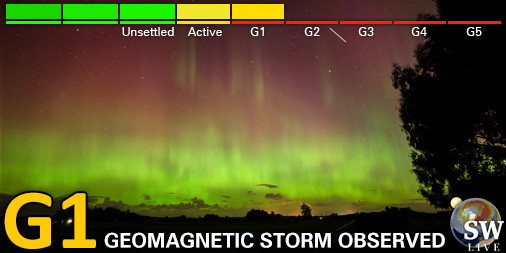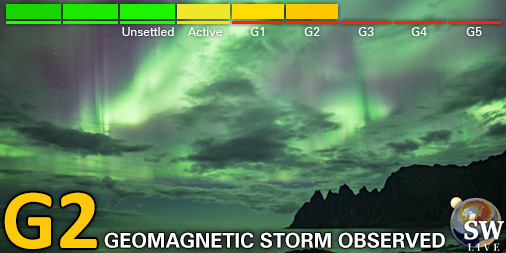Viewing archive of Wednesday, 11 April 2001
Solar activity report
Any mentioned solar flare in this report has a scaling factor applied by the Space Weather Prediction Center (SWPC). Because of the SWPC scaling factor, solar flares are reported as 42% smaller than for the science quality data. The scaling factor has been removed from our archived solar flare data to reflect the true physical units.
Report of Solar-Geophysical Activity 2001 Apr 11 2200 UTCPrepared by the NOAA © SWPC and processed by SpaceWeatherLive.com
Joint USAF/NOAA Report of Solar and Geophysical Activity
SDF Number 101 Issued at 2200Z on 11 Apr 2001IA. Analysis of Solar Active Regions and Activity from 10-2100Z to 11-2100Z
Solar activity was moderate. A single M-class event
occurred during the period. Region 9415 (S22W27) produced an M2/1f
parallel ribbon flare at 11/1326 UTC. This event was accompanied by
Type II and IV radio sweeps, a 540 sfu 10 cm radio burst, and a
full-halo coronal mass ejection (CME). Two new regions were
numbered: 9426 (S09E40) and 9427 (S07W12).
IB. Solar Activity Forecast
Solar activity is expected to be at
moderate to high levels. Region 9415 can be expected to produce
another major flare during the period.
IIA. Geophysical Activity Summary 10-2100Z to 11-2100Z
The geomagnetic field ranged from quiet to severe storm levels. Two
discernable shocks were detected by the ACE spacecraft at
approximately 11/1300 and 11/1520 UTC. These effects were most
likely the precursors for the two earth-directed CME's produced on
9-10 April. The resulting CME's arrival at earth produced severe
geomagnetic storming during the period of 11/1500-1800 UTC. The
greater than 10 MeV proton flux was at high levels all period long,
reaching a maximum of 322 PFU near the end of the period. A polar
cap absorption (PCA) event remained in effect during the period. The
greater than 2 MeV electron flux has at high levels for the first
part of the period and then decreased to moderate levels for the
remainder of the period.
IIB. Geophysical Activity Forecast
The geomagnetic field is
expected to continue at active to major storm levels during the
first day of the period. A second geomagnetic storm is expected to
arrive late on 12 April or early on 13 April UTC. This disturbance
will be the result of the full-halo CME described in Section 1A.
Brief severe storm levels at high latitudes can be expected.
Unsettled to minor storm levels are expected on 14 April as the
storm subsides. The greater than 10 MeV proton event is expected to
continue through most of the period. The PCA event is expected to
end during the latter half of the period. The greater than 2 MeV
electron flux is expected to be at mostly moderate levels during the
period.
III. Event Probabilities 12 Apr to 14 Apr
| Class M | 80% | 80% | 80% |
| Class X | 25% | 25% | 25% |
| Proton | 80% | 25% | 25% |
| PCAF | in progress | ||
IV. Penticton 10.7 cm Flux
Observed 11 Apr 160 Predicted 12 Apr-14 Apr 160/160/155 90 Day Mean 11 Apr 167
V. Geomagnetic A Indices
Observed Afr/Ap 10 Apr 007/009 Estimated Afr/Ap 11 Apr 050/060 Predicted Afr/Ap 12 Apr-14 Apr 060/090-050/050-020/025
VI. Geomagnetic Activity Probabilities 12 Apr to 14 Apr
| A. Middle Latitudes | |||
|---|---|---|---|
| Active | 15% | 15% | 35% |
| Minor storm | 25% | 25% | 15% |
| Major-severe storm | 45% | 45% | 10% |
| B. High Latitudes | |||
|---|---|---|---|
| Active | 15% | 25% | 35% |
| Minor storm | 30% | 30% | 25% |
| Major-severe storm | 50% | 35% | 15% |
All times in UTC
Current data suggests there is a slight possibility for aurora to appear at the following high latitude regions in the near future
Whitehorse, YTAnchorage, AK, Fairbanks, AK, Juneau, AK, Utqiagvik, AK
Latest news
Latest forum messages
Unspecified geomagnetic activity 2221Incoming & Unnumbered Active Regions 1660AR4048 114New satellites - Proba-3, PUNCH, SWFO-L1, GOES-U/19 36Filaments and prominences 750
More topicsSupport SpaceWeatherLive.com!
A lot of people come to SpaceWeatherLive to follow the Sun's activity or if there is aurora to be seen, but with more traffic comes higher server costs. Consider a donation if you enjoy SpaceWeatherLive so we can keep the website online!

Latest alerts
10:00 UTC - Hemispheric Power Index
The OVATION model predicts the Hemispheric Power Index to reach 78GW at 10:32 UTC
04:15 UTC - Geomagnetic activity
Minor G1 geomagnetic storm (Kp5) Threshold Reached: 04:05 UTC
03:15 UTC - Geomagnetic activity
Moderate G2 geomagnetic storm (Kp6) Threshold Reached: 02:59 UTC
01:00 UTC - Geomagnetic activity
Minor G1 geomagnetic storm (Kp5) Threshold Reached: 00:51 UTC
Friday, 4 April 2025
23:30 UTC - Geomagnetic activity
Minor G1 geomagnetic storm (Kp5) Threshold Reached: 23:17 UTC
Space weather facts
| Last X-flare | 2025/03/28 | X1.1 |
| Last M-flare | 2025/04/01 | M2.5 |
| Last geomagnetic storm | 2025/04/04 | Kp5+ (G1) |
| Spotless days | |
|---|---|
| Last spotless day | 2022/06/08 |
| Monthly mean Sunspot Number | |
|---|---|
| March 2025 | 134.2 -20.4 |
| April 2025 | 148 +13.8 |
| Last 30 days | 130.9 -15.2 |






